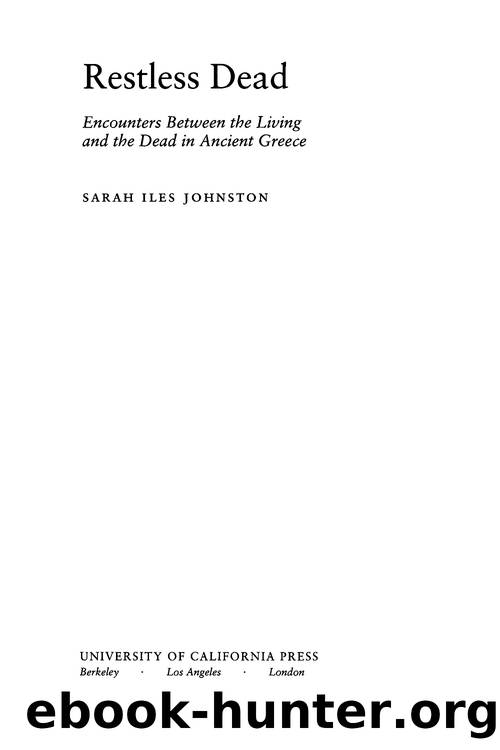Restless Dead by Johnston Sarah Iles

Author:Johnston, Sarah Iles
Language: eng
Format: epub
Tags: Literature
Publisher: University of California Press
Published: 2013-08-14T16:00:00+00:00
HECATE AND GIRLS’ TRANSITIONS
I mentioned above that one of Hecate’s earliest roles in Greek literature and art was that of a wedding attendant. In this she was similar to Artemis, who also was expected to bless weddings with her presence, ensuring the bride’s safe transition from maiden to wife. As is well known, this was but one aspect of Artemis’s general guardianship of the female’s passage from girl to mother, which also manifested itself in her presence when women gave birth, her protection of children after birth, and, even earlier in the process, her sponsorship of a variety of rituals in which girls symbolically made the transition from virgin to marriageable woman.30
Hecate, too, exhibited a concern for women that extended from the time that they were ready for marriage through childbirth—in fact, it was undoubtedly this common range of interests that led to the early association of the two goddesses. Aeschylus credits “Artemis-Hecate” with bringing labor pains to women. Antoninus Liberalis, drawing on the second-century B.C.E. poet Nicander, relates a story whereby one of the midwives present at Heracles’ birth was turned into a weasel by Hera, but then, in recompense, was honored by Hecate and became her “sacred servant” forever, which suggests that Hecate was a goddess whom midwives particularly served. Ennius mentions that Trivia (i.e., Hecate) could bestow children on fathers who prayed to her. Hesychius describes the birth goddess Genetyllis as another form of Hecate. The Chaldean Oracles make Hecate the goddess through whose grace the whole material cosmos was created, and identify her womb as the source of all life.31 Hecate’s sacred animal, the dog,32 is also suggestive of her connection with birth, for the dog was sacred to Eileithyia, Genetyllis, and other birth goddesses.33 Although in later times Hecate’s dog came to be thought of as a manifestation of the restless souls or demons who accompanied her,34 its docile appearance and its accompaniment of a Hecate who looks completely friendly in many pieces of ancient art suggests that its original signification was positive and thus likelier to have arisen from the dog’s connection with birth than the dog’s demonic associations. Of course, as in the case of Artemis, there was a darker side to Hecate’s role as birth goddess as well. A fragment from a Doric mime, perhaps by Sophron, describes her as leaving the bed of a parturient woman whom she has just killed. Like all divinities, Hecate can take away what she can give. Perhaps the women who try to avert Hecate in some other fragments from Sophron are also concerned with protecting a parturient woman and her infant.35
From earliest times, Hecate is singled out as a kourotrophos as well. Midway through the Theogony, in his so-called “Hymn to Hecate,” Hesiod calls her this twice, describing it as a characteristic that Hecate has held from the outset. She is also called kourotrophos by Apollonius Rhodius and several other later authors. The pseudo-Herodotean Life of Homer describes Samian women as sacrificing to a kourotrophic goddess at the crossroads, which must, again, indicate Hecate.
Download
This site does not store any files on its server. We only index and link to content provided by other sites. Please contact the content providers to delete copyright contents if any and email us, we'll remove relevant links or contents immediately.
| Clergy | Devotionals |
| Faith | Inspirational |
| Meditations | Monasticism & Asceticism |
| Prayer | Prayerbooks |
| Ritual | Sermons |
The Secret Power of Speaking God's Word by Joyce Meyer(2969)
More Language of Letting Go: 366 New Daily Meditations by Melody Beattie(2966)
The Holy Spirit by Billy Graham(2892)
To Light a Sacred Flame by Silver RavenWolf(2767)
Tuesdays With Morrie by Mitch Albom(2693)
The Lost Art of Good Conversation by Sakyong Mipham(2576)
The Traveler's Gift by Andy Andrews(2409)
Kundalini by Gopi Krishna(2136)
A Kingsbury Collection by Karen Kingsbury(2060)
Angels of God: The Bible, the Church and the Heavenly Hosts by Mike Aquilina(1932)
Finding Chika by Mitch Albom(1926)
Anxious for Nothing by Max Lucado(1910)
Angels by Billy Graham(1886)
As a Man Thinketh by James Allen(1861)
Curse Tablets and Binding Spells from the Ancient World by Gager John G.;(1838)
The Yoga of Jesus: Understanding the Hidden Teachings of the Gospels by Paramahansa Yogananda(1803)
Barking to the Choir by Gregory Boyle(1786)
Autobiography of a Yogi (Complete Edition) by Yogananda Paramahansa(1774)
How To Be Born Again by Billy Graham(1730)
